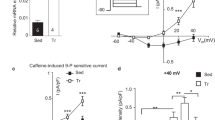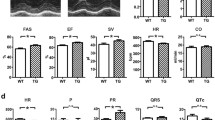Abstract
Objective
ß-adrenergic receptors (ßARs) are powerful regu- lators of cardiac function in vivo, activating heterotrimeric G proteins and the effector molecule adenylyl cyclase (AC). Interestingly, cardiac-specific overexpression of different AC isoforms leads to variable changes in cardiac function. Whether AC overexpression affects intrinsic cardiac contractility in an isoform-specific fashion determining a change in exercise capacity is currently unknown.
Methods
To address this issue, we performed load-independent measurements of cardiac systolic and diastolic function by pressure–volume (PV) loop analysis in intact wild-type mice (WT) and transgenic mice overexpressing the AC isoforms 5 or 8.
Results
Here we show that cardiac overexpression of either AC5 or AC8 transgenic mice determined an increase in intrinsic cardiac contractility. Interestingly, AC8 transgenic mice displayed a significantly greater increase in cardiac contractility and improved active phase of relaxation. Despite these differences detected by PV loop analysis, both AC5 and AC8 mice showed a marked increase in exercise capacity on treadmill testing.
Conclusions
Our results demonstrate that load-independent measurements of cardiac function are needed to compare different groups of genetically-modified mouse models and to detect subtle AC isoform-specific changes in cardiac performance.




Similar content being viewed by others
References
Bristow MR (1998) Why does the myocardium fail? Insights from basic science. Lancet 352 (Suppl 1):SI8–S14
Carroll JD, Lang RM, Neumann AL, Borow KM, Rajfer SI (1986) The differential effects of positive inotropic and vasodilator therapy on diastolic properties in patients with congestive cardiomyopathy. Circulation 74:815–825
Chiariello M, Esposito G (2006) Closing the cycle: skp2 modulates cyclic nucleotides antiproliferative effects. Circ Res 98:1113–1114
Davidson DM, Covell JW, Malloch CI, Ross J Jr (1974) Factors influencing indices of left ventricle contractility in the conscious dog. Cardiovasc Res 8:299–312
Defer N, Best-Belpomme M, Hanoune J (2000) Tissue specificity and physiological relevance of various isoforms of adenylyl cyclase. Am J Physiol Renal Physiol 279:F400–F416
Defer N, Marinx O, Stengel D, Danisova A, Iourgenko V, Matsuoka I, Caput D, Hanoune J (1994) Molecular cloning of the human type VIII adenylyl cyclase. FEBS Lett 351:109–113
Espinasse I, Iourgenko V, Richer C, Heimburger M, Defer N, Bourin MC, Samson F, Pussard E, Giudicelli JF, Michel JB, Hanoune J, Mercadier JJ (1999) Decreased type VI adenylyl cyclase mRNA concentration and Mg(2+)-dependent adenylyl cyclase activities and unchanged type V adenylyl cyclase mRNA concentration and Mn(2+)-dependent adenylyl cyclase activities in the left ventricle of rats with myocardial infarction and longstanding heart failure. Cardiovasc Res 42:87–98
Esposito G, Rapacciuolo A, Naga Prasad SV, Takaoka H, Thomas SA, Koch WJ, Rockman HA (2002) Genetic alterations that inhibit in vivo pressure-overload hypertrophy prevent cardiac dysfunction despite increased wall stress. Circulation 105:85–92
Esposito G, Santana LF, Dilly K, Cruz JD, Mao L, Lederer WJ, Rockman HA (2000) Cellular and functional defects in a mouse model of heart failure. Am J Physiol Heart Circ Physiol 279:H3101–H3112
Feldman AM (1993) Modulation of adrenergic receptors and G-transduction proteins in failing human ventricular myocardium. Circulation 87:IV27–IV34
Gao MH, Lai NC, Roth DM, Zhou J, Zhu J, Anzai T, Dalton N, Hammond HK (1999) Adenylylcyclase increases responsiveness to catecholamine stimulation in transgenic mice. Circulation 99:1618–1622
Gao T, Puri TS, Gerhardstein BL, Chien AJ, Green RD, Hosey MM (1997) Identification and subcellular localization of the subunits of L-type calcium channels and adenylyl cyclase in cardiac myocytes. J Biol Chem 272:19401–19407
Hanoune J, Defer N (2001) Regulation and role of adenylyl cyclase isoforms. Annu Rev Pharmacol Toxicol 41:145–174
Hanoune J, Pouille Y, Tzavara E, Shen T, Lipskaya L, Miyamoto N, Suzuki Y, Defer N (1997) Adenylyl cyclases: structure, regulation and function in an enzyme superfamily. Mol Cell Endocrinol 128:179–194
Harding VB, Jones LR, Lefkowitz RJ, Koch WJ, Rockman HA (2001) Cardiac beta ARK1 inhibition prolongs survival and augments beta blocker therapy in a mouse model of severe heart failure. Proc Natl Acad Sci USA 98:5809–5814
Ishikawa Y, Sorota S, Kiuchi K, Shannon RP, Komamura K, Katsushika S, Vatner DE, Vatner SF, Homcy CJ (1994) Downregulation of adenylylcyclase types V and VI mRNA levels in pacing- induced heart failure in dogs. J Clin Invest 93:2224–2229
Lai NC, Roth DM, Gao MH, Fine S, Head BP, Zhu J, McKirnan MD, Kwong C, Dalton N, Urasawa K, Roth DA, Hammond HK (2000) Intracoronary delivery of adenovirus encoding adenylyl cyclase VI increases left ventricular function and cAMP-generating capacity. Circulation 102:2396–2401
Lai NC, Roth DM, Gao MH, Tang T, Dalton N, Lai YY, Spellman M, Clopton P, Hammond HK (2004) Intracoronary adenovirus encoding adenylyl cyclase VI increases left ventricular function in heart failure. Circulation 110:330–336
Leineweber K, Bohm M, Heusch G (2006) Cyclic adenosine monophosphate in acute myocardial infarction with heart failure: slayer or savior? Circulation 114:365–367
Lipskaia L, Defer N, Esposito G, Hajar I, Garel MC, Rockman HA, Hanoune J (2000) Enhanced cardiac function in transgenic mice expressing a Ca(2+)- stimulated adenylyl cyclase. Circ Res 86:795–801
Mahler F, Covell JW, Ross J Jr (1975) Systolic pressure—diameter relations in the normal conscious dog. Cardiovasc Res 9:447–455
Nienaber JJ, Tachibana H, Naga Prasad SV, Esposito G, Wu D, Mao L, Rockman HA (2003) Inhibition of receptor-localized PI3K preserves cardiac beta-adrenergic receptor function and ameliorates pressure overload heart failure. J Clin Invest 112:1067–1079
Pak PH, Maughan L, Baughman KL, Kass DA (1996) Marked discordance between dynamic and passive diastolic pressure—volume relations in idiopathic hypertrophic cardiomyopathy [published erratum appears in Circulation 1996 Nov 15; 94(10):2668]. Circulation 94:52–60
Perrino C, Naga Prasad SV, Mao L, Noma T, Yan Z, Kim HS, Smithies O, Rockman HA (2006) Intermittent pressure overload triggers hypertrophy-independent cardiac dysfunction and vascular rarefaction. J Clin Invest 116:1547–1560
Perrino C, Naga Prasad SV, Schroder JN, Hata JA, Milano C, Rockman HA (2005) Restoration of beta-adrenergic receptor signaling and contractile function in heart failure by disruption of the betaARK1/phosphoinositide 3-kinase complex. Circulation 111:2579–2587
Ping P, Anzai T, Gao M, Hammond HK (1997) Adenylyl cyclase and G protein receptor kinase expression during development of heart failure. Am J Physiol 273:H707–H717
Ping P, Gelzer-Bell R, Roth DA, Kiel D, Insel PA, Hammond HK (1995) Reduced beta-adrenergic receptor activation decreases G-protein expression and beta-adrenergic receptor kinase activity in porcine heart. J Clin Invest 95:1271–1280
Rockman HA, Koch WJ, Lefkowitz RJ (2002) Seven-transmembrane-spanning receptors and heart function. Nature 415:206–212
Roth DM, Bayat H, Drumm JD, Gao MH, Swaney JS, Ander A, Hammond HK (2002) Adenylyl cyclase increases survival in cardiomyopathy. Circulation 105:1989–1994
Roth DM, Gao MH, Lai NC, Drumm J, Dalton N, Zhou JY, Zhu J, Entrikin D, Hammond HK (1999) Cardiac-directed adenylyl cyclase expression improves heart function in murine cardiomyopathy. Circulation 99:3099–3102
Takaoka H, Esposito G, Mao L, Suga H, Rockman HA (2002) Heart size-independent analysis of myocardial function in murine pressure overload hypertrophy. Am J Physiol Heart Circ Physiol 282:H2190–H2197
Tang T, Lai NC, Roth DM, Drumm J, Guo T, Lee KW, Han PL, Dalton N, Gao MH (2006) Adenylyl cyclase type V deletion increases basal left ventricular function and reduces left ventricular contractile responsiveness to beta-adrenergic stimulation. Basic Res Cardiol 101:117–126
Tepe NM, Liggett SB (1999) Transgenic replacement of type V adenylyl cyclase identifies a critical mechanism of beta-adrenergic receptor dysfunction in the G alpha q overexpressing mouse. FEBS Lett 458:236–240
Tepe NM, Lorenz JN, Yatani A, Dash R, Kranias EG, Dorn GW IInd, Liggett SB (1999) Altering the receptor–effector ratio by transgenic overexpression of type V adenylyl cyclase: enhanced basal catalytic activity and function without increased cardiomyocyte beta-adrenergic signalling. Biochemistry 38:16706–16713
Ungerer M, Parruti G, Bohm M, Puzicha M, DeBlasi A, Erdmann E, Lohse MJ (1994) Expression of beta-arrestins and beta-adrenergic receptor kinases in the failing human heart. Circ Res 74:206–213
Acknowledgements
This work was supported, in part, by grant HL56687 (NIH) to Howard A. Rockman and by grant PRIN2005 by Ministero dellUniversità e della Ricerca Scientifica to Massimo Chiariello.
Author information
Authors and Affiliations
Corresponding author
Additional information
Returned for 1. revision: 2 January 2007 1. Revision received: 16 August 2007
Returned for 2. revision: 24 September 2007 2. Revision received: 2 October 2007
Giovanni Esposito and Cinzia Perrino equally contributed to this work.
Rights and permissions
About this article
Cite this article
Esposito, G., Perrino, C., Ozaki, T. et al. Increased myocardial contractility and enhanced exercise function in transgenic mice overexpressing either adenylyl cyclase 5 or 8. Basic Res Cardiol 103, 22–30 (2008). https://doi.org/10.1007/s00395-007-0688-6
Received:
Accepted:
Published:
Issue Date:
DOI: https://doi.org/10.1007/s00395-007-0688-6




